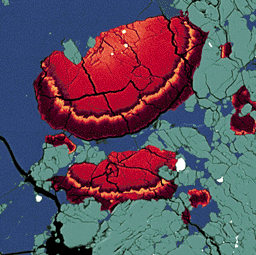[ Glossary | General Resources | Comments | Top of page ]
 There is a drastic difference of opinion about the temperature at which the carbonate globules formed. This debate is not surprising in light of how complicated the globules are. In this colorized image made with an electron microprobe green is orthopyroxene (a silicate with iron and magnesium), blue is glassy plagioclase feldspar, and the various shades of red and orange are carbonate minerals that vary widely in chemical composition. On the basis of the elemental abundances in the carbonate minerals, Ralph Harvey (Case Western Reserve University) argues that the temperature could have been as high as 700 degrees Celsius, far too hot for any form of life to survive. He argues that the high temperatures resulted from a meteorite impact. A counter argument is that the system was not in chemical equilibrium, which Harvey assumed when making his temperature estimate. Bacteria are capable of producing products quite different than those made by purely inorganic chemical processes. On the other hand, formation of the carbonate minerals from water ought to have produced some water-bearing minerals, but these have not been detected.
There is a drastic difference of opinion about the temperature at which the carbonate globules formed. This debate is not surprising in light of how complicated the globules are. In this colorized image made with an electron microprobe green is orthopyroxene (a silicate with iron and magnesium), blue is glassy plagioclase feldspar, and the various shades of red and orange are carbonate minerals that vary widely in chemical composition. On the basis of the elemental abundances in the carbonate minerals, Ralph Harvey (Case Western Reserve University) argues that the temperature could have been as high as 700 degrees Celsius, far too hot for any form of life to survive. He argues that the high temperatures resulted from a meteorite impact. A counter argument is that the system was not in chemical equilibrium, which Harvey assumed when making his temperature estimate. Bacteria are capable of producing products quite different than those made by purely inorganic chemical processes. On the other hand, formation of the carbonate minerals from water ought to have produced some water-bearing minerals, but these have not been detected.
|
|
[ About PSRD |
Archive |
Search |
Subscribe ] [ Glossary | General Resources | Comments | Top of page ] |